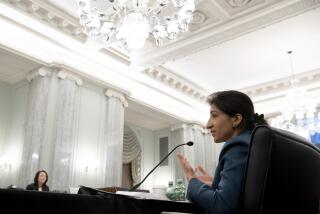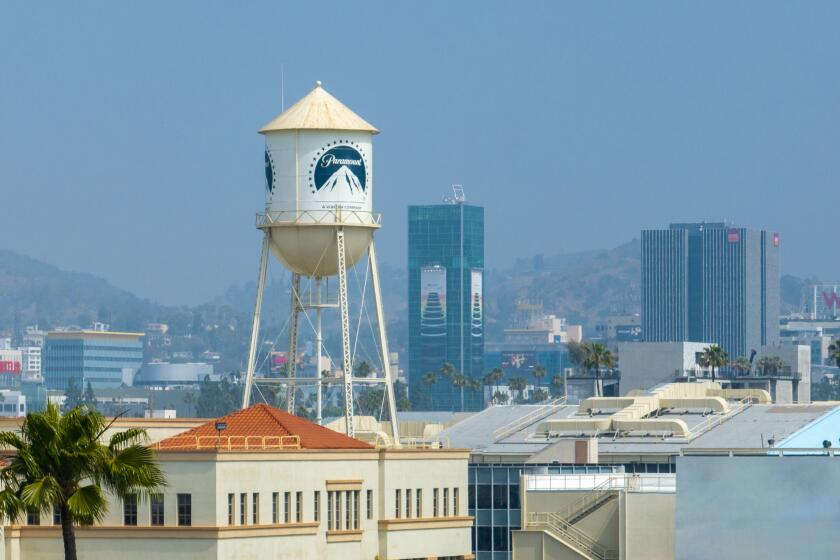‘Joe Camel’ Ads Illegally Target Youths, FTC Says
- Share via
WASHINGTON — Adding to the tobacco industry’s mounting problems, the Federal Trade Commission charged Wednesday that R.J. Reynolds’ highly successful “Joe Camel” ad campaign illegally induces children and adolescents to smoke.
By a 3-2 vote, the commission decided to ask an administrative law judge for a cease and desist order to prevent the nation’s second-largest cigarette manufacturer from using the cartoon camel in ways that “would have a substantial appeal to children and adolescents below the age of 18.”
Reynolds said it would vigorously challenge the FTC’s order. The two commissioners who voted against the action also issued statements questioning the wisdom of the FTC’s move.
If the agency prevails, the cease and desist order would keep Joe Camel--complete with dangling cigarette, dark glasses and attractive friends--out of magazine pages and off roadside billboards. Cigarette ads have already been banned from television.
The FTC also wants RJR to produce marketing data about the product’s sales to underage consumers and to produce an advertising campaign to warn kids about smoking.
“Joe Camel has become as recognizable to kids as Mickey Mouse,” said Jodie Bernstein, director of the FTC’s consumer trade protection bureau. “Yet the campaign promotes a product that causes serious injury, addiction and death.”
In its complaint, the FTC alleged that RJR initiated the use of Joe Camel as its advertising symbol to attract underage smokers to Camels, hoping teens would adopt the product as their “first usual brand” to build loyalty and increase market share as they grow older.
“The campaign has been successful,” Bernstein said at a news conference. “We believe it has had a very significant impact on underage smokers.”
RJR, however, defended the use of its advertising symbol, calling the FTC’s action “unprecedented, unfounded and unwarranted.”
“Joe Camel has become the government’s scapegoat for issues our society has been unable to resolve,” according to a statement from the company.
Reynolds said that very few teenage smokers--only 3.1%--choose Camels. “If there is an argument to be made about the effect of advertising on purchase decisions, there is only one conclusion that can be reached relative to Joe Camel: it has not made Camel the brand of choice of underage smokers,” the company said.
RJR said it expects to prevail in the administrative hearing that is scheduled to begin June 24. Any decision made by the law judge would be reviewed by the five FTC commissioners and could be appealed in federal court.
Harvard constitutional law professor Laurence H. Tribe said he expected the FTC action to survive any 1st Amendment challenge by RJR.
“The Supreme Court’s decisions about promoting the sale of products through advertisements make clear that although commercial speech is protected by the 1st Amendment, that protection does not include the right to promote a service or product that is illegal for those to whom it is promoted, or in a way that is deceptive,” Tribe said.
“Here, the FTC has accumulated a powerful record to support the proposition that the Joe Camel campaign is intentionally designed to induce the illegal purchase of cigarettes by minors. To the extent that the record supports that conclusion, the FTC is not trampling on the 1st Amendment in the least.”
The FTC action, which reversed a decision taken three years ago, was another sign of the industry’s waning fortunes and its declining clout in Washington. The move was quickly hailed by vocal tobacco foes in Congress.
It’s “another example of the growing momentum against the tobacco industry,” said Rep. Henry A. Waxman (D-Los Angeles).
Some academics who have studied the impact of the Joe Camel campaign, including Dr. Joseph Di Franza at the University of Massachusetts, also praised the FTC move, although they lamented the time it took the FTC to act. The Joe Camel campaign was unveiled in the U.S. in 1988 and was controversial almost from the start.
Di Franza co-authored a study in 1991, published in the Journal of the American Medical Assn., that described how sales of Camels to minors had skyrocketed in the previous three years.
To uphold its charges against RJR, the FTC must provide evidence to the administrative judge to support its claim that the company engaged in an unfair trade practice.
According to Bernstein, the commissioners have information that indicates Camel cigarettes held less than 3% of underage market share in 1987 and that it had risen to between 13% and 16% by 1993--largely as a result of the Joe Camel advertising campaign. That information was available to the commissioners in 1994, but proved unpersuasive to a majority who voted 3-2 not to take action against RJR at the time.
Bernstein declined to say what new information led to a different outcome this time. However, the composition of the commission has changed since the last vote--two of the three commissioners who voted in favor of bringing charges Wednesday are new. Also, a variety of internal RJR documents has become public in recent years as a result of litigation, and industry critics say those documents give teeth to the FTC’s case.
The FTC action comes amid mounting troubles for the tobacco industry, including the recent decision of a North Carolina federal judge that the Food and Drug Administration has the right to regulate the industry and its use of nicotine, the key chemical component of cigarettes.
Although FTC officials stoutly defended its actions as “law enforcement” and devoid of political considerations, the complaint comes as state attorneys general and tobacco firm executives are racing against the clock to reach a settlement before a series of lawsuits seeking industry compensation for medical costs caused by tobacco-related illnesses go to trial, starting in July.
Bernstein said the commissioners considered the tobacco talks but decided to proceed with its complaint instead of waiting to see what came of those talks. Indeed, according to sources familiar with the negotiations, the industry is trying to craft a massive legal accord, which could include some kind of limit on its future liability suits in exchange for voluntary limits on its advertising and marketing programs.
The decision to issue the complaint, however, drew criticism from the two dissenting commissioners, Mary L. Azcuenaga and Roscoe B. Starek III.
Along with former Commissioner Deborah K. Owen, Azcuenaga and Starek formed the majority that refused to issue a complaint against RJR’s use of Joe Camel ads in 1994. At that time, a majority of commissioners said there wasn’t enough information to make the case that Joe Camel enticed children to smoke.
Times staff writer Denise Gellene in Los Angeles contributed to this story. Fulwood reported from Washington and Weinstein from Los Angeles.
(BEGIN TEXT OF INFOBOX / INFOGRAPHIC)
Joe Camel’s Career
* Born: In 1974, on a poster used in a French advertising campaign for Camel cigarettes.
* U.S. arrival: In 1987, when a North Carolina advertising agency imports him to celebrate the brand’s 75th anniversary.
* Success as icon: In 1991, when he came out with own line of merchandise, advertising billings were estimated at $40 million a year.
* Downfall as icon: The Journal of the American Medical Assn. published a study in 1991 claiming that 6-year-olds identified Joe Camel as readily as Mickey Mouse.
Sources: Los Angeles Times and Advertising Age
(BEGIN TEXT OF INFOBOX / INFOGRAPHIC)
Brand Preferences
The Centers for Disease Control and Prevention compared the preferred cigarette brands among teenagers and adults with what tobacco companies spend on advertising the same brands. All figures are for 1993, the year the CDC performed the study.
Advertising
Brand: In millions
Marlboro: $75
Camel: $43
Newport: $35
Kool: $21
Winston: $17
Benson & Hedges: $4
Salem: $3
*
Teen Preference
Brand: Share
Marlboro: 60.0%
Camel: 13.3%
Newport: 12.7%
Kool: 1.2%
Winston: 1.2%
Salem: 1.0%
Benson & Hedges: 0.3%
*
Adult Preference
Brand: Share
Marlboro: 23.5%
Camel: 6.7%
Newport: 4.8%
Camel: 3.9%
Salem: 3.9%
Kool: 3.0%
Benson & Hedges: 2.5%
Source: Centers for Disease Control and Prevention via the Internet
More to Read
Inside the business of entertainment
The Wide Shot brings you news, analysis and insights on everything from streaming wars to production — and what it all means for the future.
You may occasionally receive promotional content from the Los Angeles Times.










